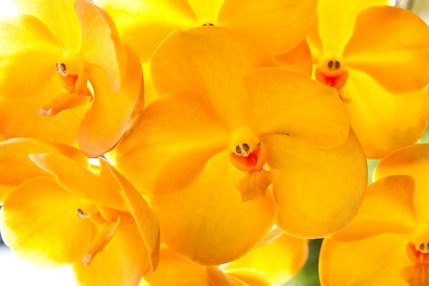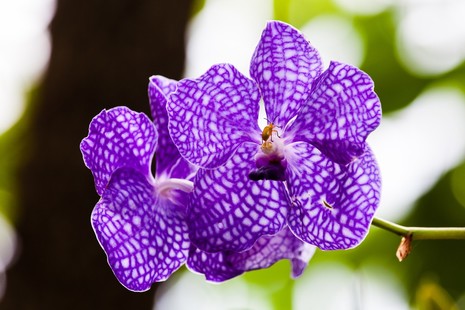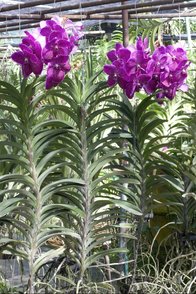Vandas at a Glance
Temperature: 70° – 95° F days, 60° – 70° F nights
Water: Water often but allow to dry out between watering
Light: 25 – 35% bright filtered light
Humidity: 70 – 90%
Food: Once a week during growing season, less in winter
Water: Water often but allow to dry out between watering
Light: 25 – 35% bright filtered light
Humidity: 70 – 90%
Food: Once a week during growing season, less in winter
The name Vanda will be used here to cover all Vandaceous orchids including Vanda, Ascocentum, Aerides, Renanthera, Rhynchostylis, etc. and the hybrids between them.
Although there are some Vandaceous orchids that originate in mountainous areas, most are low-level plants that love warm temperatures. Vandas are found throughout the Eastern Hemisphere with the center of distribution being Southeast Asia. One important species, Vanda (Euanthe) sanderiana, figures prominently in many hybrids and is native to the Philippines.
Although there are some Vandaceous orchids that originate in mountainous areas, most are low-level plants that love warm temperatures. Vandas are found throughout the Eastern Hemisphere with the center of distribution being Southeast Asia. One important species, Vanda (Euanthe) sanderiana, figures prominently in many hybrids and is native to the Philippines.

Flowers
Vandas may be small plants with many small brightly-colored flowers or large plants with large flowers. Many Vandas can have a powerful fragrance. Rhynchostylis and Aerides are noted for their delightful citrus or musky scent.
One of the most desirable qualities of Vandas is the wide range of pure, brilliant colors. Yellow, orange, scarlet, deep purple and bright fuchsia are all part of the Vandaceous color palette. Some flowers sport exotic markings or can be covered with spots or stripes.
Another desirable feature of many Vanda hybrids, such as Ascocenda, is their tendency to bloom several times throughout the year when they are given the proper conditions. Coupled with long-lasting flowers, it can indeed seem as if they are in continuous bloom. It is not unusual for growers in Florida and Hawaii to have Ascocendas bloom five times per year.
Climate
Vandas require constant warm temperatures and high humidity throughout the year.
Vandas may be small plants with many small brightly-colored flowers or large plants with large flowers. Many Vandas can have a powerful fragrance. Rhynchostylis and Aerides are noted for their delightful citrus or musky scent.
One of the most desirable qualities of Vandas is the wide range of pure, brilliant colors. Yellow, orange, scarlet, deep purple and bright fuchsia are all part of the Vandaceous color palette. Some flowers sport exotic markings or can be covered with spots or stripes.
Another desirable feature of many Vanda hybrids, such as Ascocenda, is their tendency to bloom several times throughout the year when they are given the proper conditions. Coupled with long-lasting flowers, it can indeed seem as if they are in continuous bloom. It is not unusual for growers in Florida and Hawaii to have Ascocendas bloom five times per year.
Climate
Vandas require constant warm temperatures and high humidity throughout the year.

Light Requirements
Vandas require more light than other groups of orchids, although many growers in northern climates grow and flower them successfully using grow lights or fluorescent tubes. In Southeast Asia Vandas are often grown outdoors in beds of coconut husk under a light layer of shade cloth or even full sun. The Hawaiian lei orchid, Vanda Miss Joaquim, is often grown as an ornamental hedge in South Florida.
Watering Requirements
Unlike Cattleyas or Dendrobiums, Vandas have no water storage device. Consequently, they must be watered more frequently. Growers in warm tropical areas may water their Vandas every day during spring and summer.
Feeding Requirements
Vandas are also greedy feeders and bloom better if fed regularly – weekly during the warm months and every other week in winter. Better-Gro® plant foods are recommended especially because they contain NO urea nitrogen, allowing this essential element readily available to your orchids.
Vandas require more light than other groups of orchids, although many growers in northern climates grow and flower them successfully using grow lights or fluorescent tubes. In Southeast Asia Vandas are often grown outdoors in beds of coconut husk under a light layer of shade cloth or even full sun. The Hawaiian lei orchid, Vanda Miss Joaquim, is often grown as an ornamental hedge in South Florida.
Watering Requirements
Unlike Cattleyas or Dendrobiums, Vandas have no water storage device. Consequently, they must be watered more frequently. Growers in warm tropical areas may water their Vandas every day during spring and summer.
Feeding Requirements
Vandas are also greedy feeders and bloom better if fed regularly – weekly during the warm months and every other week in winter. Better-Gro® plant foods are recommended especially because they contain NO urea nitrogen, allowing this essential element readily available to your orchids.

